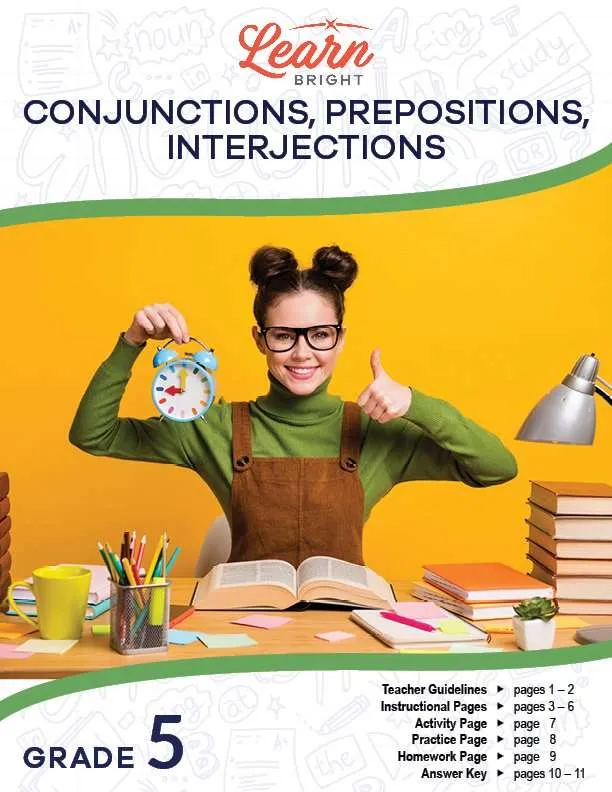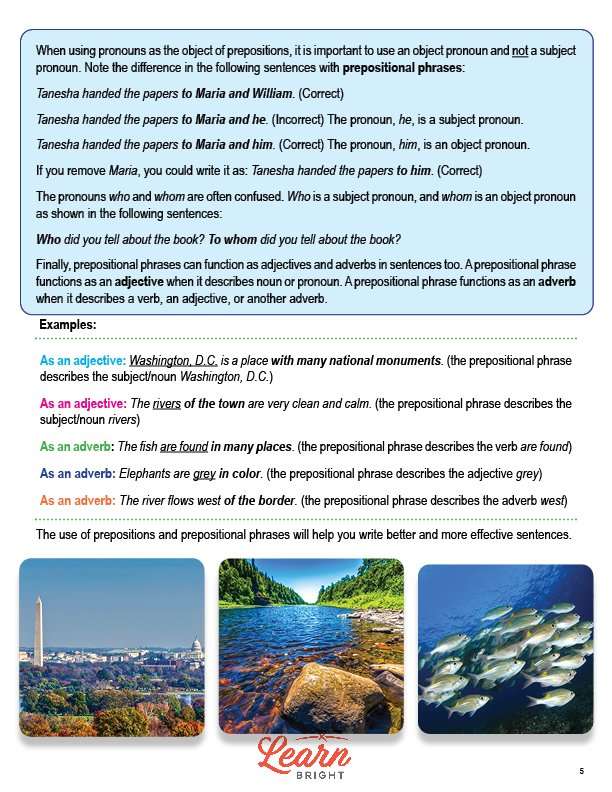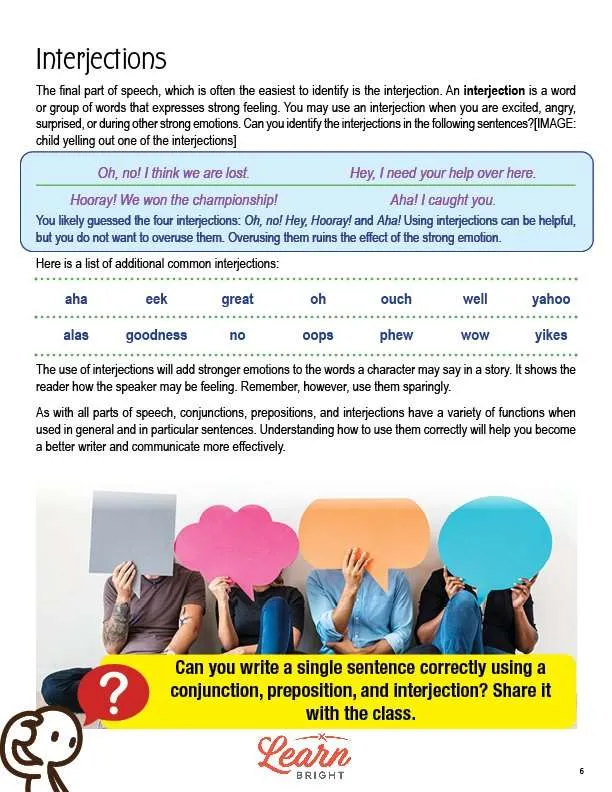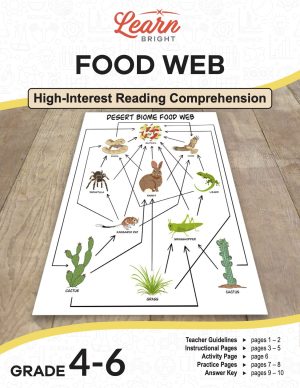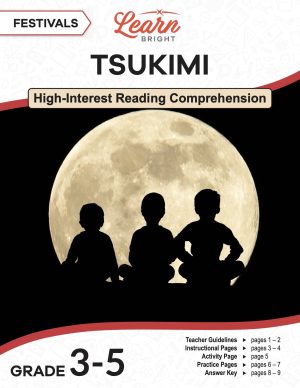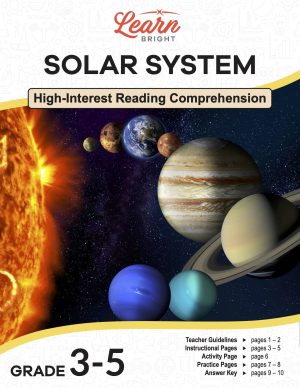Description
What our Conjunctions, Prepositions, Interjections lesson plan includes
Lesson Objectives and Overview: Conjunctions, Prepositions, Interjections teaches students all about conjunctions, prepositions, and interjections and how to properly use them. At the end of the lesson, students will be able to explain the function of conjunctions, prepositions, and interjections in general and their function in particular sentences. This lesson is for students in 5th grade.
Classroom Procedure
Every lesson plan provides you with a classroom procedure page that outlines a step-by-step guide to follow. You do not have to follow the guide exactly. The guide helps you organize the lesson and details when to hand out worksheets. It also lists information in the green box that you might find useful. You will find the lesson objectives, state standards, and number of class sessions the lesson should take to complete in this area. In addition, it describes the supplies you will need as well as what and how you need to prepare beforehand. The supplies you will need for the lesson are scissors, containers, and the handouts.
Options for Lesson
Included with this lesson is an “Options for Lesson” section that lists a number of suggestions for activities to add to the lesson or substitutions for the ones already in the lesson. One optional adjustment to the lesson activity is to include additional prepositions, conjunctions, and interjections. For an additional activity, you can create three groups, assign each group a different part of speech, and have them conduct a conversation using that part of speech as often as possible. You can also have your students create a poster that shows how to use different parts of speech, including applicable vocabulary. Finally, you can have your students identify the prepositions, interjections, conjunctions in their current reading and other subject content.
Teacher Notes
The teacher notes page includes a paragraph with additional guidelines and things to think about as you begin to plan your lesson. This page also includes lines that you can use to add your own notes as you’re preparing for this lesson.
CONJUNCTIONS, PREPOSITIONS, INTERJECTIONS LESSON PLAN CONTENT PAGES
Conjunctions
The Conjunctions, Prepositions, Interjections lesson plan includes four content pages. We use conjunctions all the time without even realizing it! They’re words that join words or groups of words together in a sentence. They’re like the glue that keeps the words in a sentence together.
The three most common conjunctions are and, but, and or. These are coordinating conjunctions. We use them for compound subjects (two subjects), compound predicates (two predicate-verbs), and compound sentences that include commas.
An example of a compound subject is: California and Oregon are located on the western coast of the United States. An example of a compound predicate is: I can either attend the party or watch a movie with my friends. And an example of a compound sentence is: I would help you with the homework, but my mother needs help in our yard.
In the compound sentence, note that we place a comma before the conjunction. We don’t use a comma when we use the conjunction with compound subjects or predicates. This is a common error! It’s also important to note that the three common conjunctions have different meanings and we can’t use them interchangeably.
And introduces an additional idea or item, but introduces a contrasting idea or item, and or introduces choices and other possibilities. We also have pairs of conjunctions that we call correlative conjunctions: either/or, neither/nor, and both/and. These join the same kinds of words as coordinating conjunctions but we use them in the same sentence.
The lesson includes example of each of the correlative conjunctions. It also points out that the different pairs of correlative conjunctions have different meanings. We use conjunctions to better clarify subjects, predicates, and other parts of sentences.
Prepositions
We also use prepositions all the time! These are words that relate a noun or pronoun to another word in a sentence. We have many different prepositions. Some of the most common one and two word prepositions are aboard, among, below, except, like, out, and toward. The lesson includes many, many other examples.
The lesson also includes several example sentences using prepositions and describes what the preposition is doing in each sentence. In the sentence The phone on the table is broken, the preposition on shows the relationship between the phone and the table.
Most prepositions are part of a prepositional phrase, which is a group of words beginning with a preposition and ending with a noun or pronoun. We call this ending noun or pronoun the object of the preposition. We can use prepositional phrases in any part of a sentence, and we can also use more than one in a sentence. One example of this is Following school, Noah walked around the block and to the supermarket. Around the block and to the supermarket are both prepositional phrases.
When you use pronouns as the object of a preposition, you should make sure to use an object pronoun instead of a subject pronoun. The lesson includes some example sentences to illustrate this. The phrases Maria and William and Maria and him are both correct, while the phrase Maria and he is incorrect because he is a subject pronoun.
People also often confuse the pronouns who and whom. Who is a subject pronoun while whom is an object pronoun.
We can also use prepositional phrases as adjectives or adverbs. They function as adjectives when they describe nouns or pronouns. They function as adverbs when they describe a verb, an adjective, or another adverb. The lesson includes examples of prepositional phrases used as adjectives and adverbs.
Interjections
Interjections are easy to identify! They’re words or groups of words that express a strong feeling. We use them when we are excited, angry, surprised, or during other strong emotions. The lesson includes some example sentences that use the interjections Oh, no!, Hey!, Hooray!, and Aha! It’s important not to overuse interjections in your writing and speaking, as this can dilute the emotions that you’re trying to express.
Some other common interjections include aha, eek, great, oh, and ouch. The lesson lists more as well. Using interjections adds stronger emotions to your writing, especially in dialogue.
Conjunctions, prepositions, and interjections all have many different uses. It’s important to understand how to use them. Mastering them will make you a better speaker and writer!
CONJUNCTIONS, PREPOSITIONS, INTERJECTIONS LESSON PLAN WORKSHEETS
The Conjunctions, Prepositions, Interjections lesson plan includes three worksheets: an activity worksheet, a practice worksheet, and a homework assignment. You can refer to the guide on the classroom procedure page to determine when to hand out each worksheet.
CUT OUT ACTIVITY WORKSHEET
Students will work with a partner to complete the activity worksheet. Each pair will cut out the conjunctions, prepositions, and interjections on the worksheet, fold them, and place them in a container. They will then take turns randomly choosing a word and using it in a conversation with their partner.
Students may work alone or in groups for the activity.
FOUR EXERCISES PRACTICE WORKSHEET
For the practice worksheet, students will complete four short exercises. For the first, they will circle the conjunctions in the given sentences and tell whether they form a compound subject, a compound predicate, or a compound sentence. Next, for the second, they will identify the prepositions from the sentences in the first exercise. For the third, they will read sentences and underline the prepositional phrases. Finally, for the fourth, they will use the provided interjections in sentences.
CONJUNCTIONS, PREPOSITIONS, INTERJECTIONS HOMEWORK ASSIGNMENT
The homework assignment asks students to first tell whether the underlined prepositional phrases in the given sentences are adjectives or adverbs. Next, they will replace the underlined word in each sentence with the correct object pronoun. Finally, they will write sentences using the provided correlative conjunctions and prepositions.
Worksheet Answer Keys
This lesson plan includes answer keys for the practice worksheet and the homework assignment. If you choose to administer the lesson pages to your students via PDF, you will need to save a new file that omits these pages. Otherwise, you can simply print out the applicable pages and keep these as reference for yourself when grading assignments.

